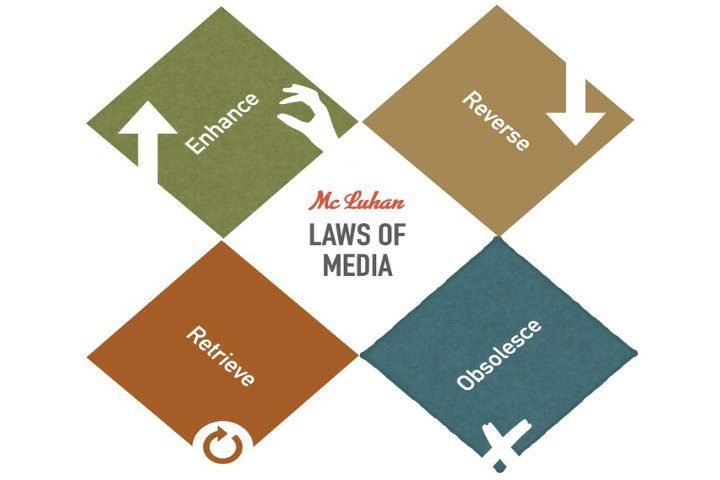Marshall McLuhan’s The Medium is the Message Theory
[tqb_quiz id=’13515′]
McLuhan’s theory of technological determination, developed in the 1960s, asserts that technology, particularly communication technology, is the primary driver of social change and cultural development. According to this view, the medium through which information is transmitted is more important than the content itself. McLuhan famously stated, “The medium is the message,” emphasizing how the nature of a medium shapes the way we perceive and interact with information.
UGC-NET aspirants in mass communication and journalism must understand McLuhan’s ideas, as they reveal the significant influence of media on culture and social structures.
This theory is relevant in India due to the country’s rapid technological adoption and the significant role of media in its diverse social landscape. This exploration examines McLuhan’s Technological Determinism, focusing on its key concepts, applications, strengths, limitations, and relevance in the Indian media and communication context.
Key Concepts of McLuhan’s Technological Determinism
1. The Medium is the Message
2. Hot and Cool Media
3. Global Village
4. Tetrad of Media Effects
5. Extensions of Man
Let’s examine each of these concepts in detail:
The Medium is the Message

This concept suggests that the medium through which a message is conveyed is more important than the content of the message itself. McLuhan argued that the medium shapes how we perceive and interpret information, fundamentally altering our social and psychological processes.
Here are some key aspects of this concept:
- Focus on the medium itself: McLuhan argued that people tend to focus on the obvious, which is the content, while ignoring the less obvious—the medium. He believed that the medium has a more significant impact on society than the content it carries.
- Medium shapes perception: The information transmission method impacts our understanding and interpretation of that information. Different media create different sensory experiences, shaping our understanding and interpretation of the message.
- Social and cultural impact: McLuhan believed that media, regardless of their content, significantly influence human psychology and society. For example, he argued that the invention of the printing press led to nationalism, industrialization, and cultural uniformity.
- Personal and social consequences: New media technologies introduce new “scales” that impact personal and social consequences. For instance, the introduction of television changed family dynamics and social interactions.
- Media as environments: McLuhan viewed media as active processes that shape our environment and influence our behavior and thoughts, rather than merely passive channels of information.
- Technological determinism: This concept is central to McLuhan’s theory of technological determinism, which declares that technology, particularly communication technologies, is the primary driver of social change.
Hot and Cool Media
McLuhan’s concept of “Hot and Cool Media” is a way of categorizing different types of media based on their level of audience participation and sensory involvement.
Hot Media: It is high-definition media with a single sense extended in “high.” It has low audience participation and is content-heavy.
Cool Media: It refers to lower-definition media that need more active audience participation to complete the experience.
Let’s examine this concept in detail:
| Aspect | Hot Media | Cool Media |
| Audience Participation | Low | High |
| Sensory Involvement | Engages one senses more completely | Engages multiple senses less completely |
| Information Density | High – provides more information | Low – provides less information |
| Audience Effort | Requires less effort to process | Requires more effort to interpret |
| Examples | Radio, film, lectures, photographs | Television, comics, telephone conversations, seminars |
| Cultural Impact | Tends to contribute to the fragmentation of society | Tends to promote unification |
| Audience Engagement | Creates passive consumers of information | Encourages active participation and engagement |
| Information Provided | Complete sensory data | Less complete sensory data |
| Intensity | More intense and focused | Less intense, more open to interpretation |
| Historical Context | Can change over time (e.g., radio became “cooler” when TV emerged) | This can change over time as new media forms develop |
Global Village

Marshall McLuhan’s concept of the “Global Village” is closely intertwined with his theory of technological determinism. Building on his technological determinism theory, McLuhan introduced the “Global Village” concept in his 1962 book “The Gutenberg Galaxy.” This idea suggests that electronic media, particularly television at the time, was collapsing space and time barriers, effectively shrinking the world into a single interconnected community.
Key aspects of the Global Village concept:
a) Instantaneous communication: Electronic media enables real-time communication across vast distances, creating a sense of immediacy and shared experience.
b) Breakdown of cultural barriers: As information flows more freely, cultural distinctions begin to blur, leading to a more homogenized global culture.
c) Increased awareness: People become more conscious of global events and issues, fostering a sense of global citizenship.
McLuhan argued that the Global Village would have profound effects on various aspects of society:
a) Politics: Increased global awareness would influence political decisions and public opinion on a global scale.
b) Economy: Global markets would become more interconnected and interdependent.
c) Culture: A tension between global homogenization and local identity preservation would emerge.
d) Education: Instant access to information would challenge traditional educational models.
Tetrad of Media Effects

McLuhan’s Tetrad of Media Effects is an analytical tool that stems from his broader theory of technological determination. It provides a framework for examining the impact of technologies, particularly communication technologies, on society.
Background and Context: Marshall McLuhan and his son Eric McLuhan introduced the Tetrad of Media Effects in their 1988 book “Laws of Media: The New Science.” It continues McLuhan’s earlier work on media theory and technological determinism, which holds that a society’s dominant communication technologies significantly influence its nature.
The tetrad consists of four laws or questions that can be applied to any technology or medium:
- Enhancement: What does the medium enhance or intensify?
- Obsolescence: What does the medium make obsolete or displace?
- Retrieval: What does the medium retrieve that was previously obsolete?
- Reversal: What does the medium flip into when pushed to its limits?
The tetrad remains a valuable tool for analyzing contemporary digital technologies:
Social Media: Enhances connectivity, obsolesces some face-to-face interactions, retrieves tribal-like group formations, and may reverse into isolation or information overload.
Artificial Intelligence: Enhances data processing capabilities, may make certain human cognitive tasks obsolete, retrieves complex pattern recognition abilities, and could potentially reverse into scenarios where AI controls human decision-making.
Extensions of Man
McLuhan’s “Extensions of Man” theory asserts that all technologies and media are extensions of some physical, mental, or social aspect of humans. This idea was most prominently explored in his 1964 book “Understanding Media: The Extensions of Man.”
This concept aligns with technological determinism by emphasizing how technologies shape human experience and society. It suggests that as we create technologies, they reshape us and our world.
McLuhan identified various ways technologies extend human capabilities:
| Type of Extension | Description | Examples |
| Physical Extensions | Technologies that extend our physical capabilities | Vehicles (e.g., cars, bicycles), Clothing |
| Sensory Extensions | Technologies that amplify or extend our senses | Devices that extend our vision, hearing, and audio-visual perception, like telescope and microscope |
| Nervous System Extensions | Technologies that extend our information processing and cognitive capabilities | Various forms of electronic media and computers |
| Social Extensions | Technologies and structures that extend our social capabilities | Cities and institutions allow us to organize and interact on a larger scale. |
Applications of McLuhan’s Media Theory
Let’s explore how this theory can be applied to various scenarios in the Indian context:
Impact of Social Media on Political Discourse in India
Medium is the Message: McLuhan’s famous phrase “the medium is the message” is particularly relevant to Twitter’s impact on Indian political communication. The platform’s 280-character limit and real-time nature have fundamentally altered how politicians engage with the public and each other.
- Brevity and Immediacy: Politicians must condense complex ideas into short, impactful statements, leading to more direct, often polarizing communication.
- Viral Potential: The ease of sharing tweets has made it possible for messages to spread rapidly, influencing public opinion at unprecedented speeds.
- Direct Engagement: Twitter has reduced the distance between politicians and citizens, allowing for more immediate interaction and feedback.
These characteristics of the medium itself are shaping political discourse, often prioritizing quick, attention-grabbing statements over nuanced policy discussions.
Global Village: Social media platforms have created a “Global Village” effect in Indian politics by connecting voters across vast geographical and social boundaries.
- Nationwide Conversations: Issues can quickly become national talking points, transcending regional and linguistic barriers.
- Diaspora Engagement: Indian citizens living abroad can now participate more actively in domestic political discussions.
- Cross-Regional Understanding: Voters in different states can more easily share and understand diverse political perspectives nationwide.
This interconnectedness is reshaping the political landscape, making it more national in scope while paradoxically also allowing for more niche, interest-based political movements.
Extensions of Man: In the context of political participation and activism, social media acts as an extension of human capabilities:
- Extended Reach: Individuals can now broadcast their political views to a vast audience, extending their voice beyond physical limitations.
- Amplified Organization: Social media allows us to organize and mobilize, facilitating everything from online petitions to on-ground protests.
- Enhanced Monitoring: Citizens can now act as watchdogs, instantly sharing and discussing political developments, thus extending societal oversight of political processes
Television and Cultural Change in India
Hot and Cool Media: McLuhan categorized media as “hot” (high-definition, low participation) or “cool” (low-definition, high participation). The shift from traditional storytelling to television serials in India illustrates this concept:
- Traditional Storytelling (Cool Medium): Often interactive, leaving much to the audience’s imagination.
- Television Serials (Hot Medium): Provide more sensory data, requiring less audience participation to fill in gaps.
This shift has impacted Indian culture by changing how stories are consumed and interpreted, potentially reducing the active role of the audience in the storytelling process.
Tetrad Analysis: Applying McLuhan’s Tetrad to television in India:
- Enhancement: TV has enhanced visual storytelling, bringing stories to life with vivid imagery and sound.
- Obsolescence: Certain traditional art forms like street theater or puppetry have been marginalized.
- Retrieval: TV has retrieved oral traditions in a new form, presenting mythological epics and folktales to mass audiences.
- Reversal: When pushed to extremes, TV might reverse into a tool for cultural homogenization, potentially eroding local cultural diversity.
Strengths of McLuhan’s Technological Determinism
Predictive Power
McLuhan’s theory has shown remarkable foresight, anticipating many aspects of our current digital landscape decades before they materialized.
- Global Village: McLuhan predicted the emergence of a globally connected world, realized through the internet and social media.
- Sensory Balance Shift: He anticipated how electronic media would shift the balance of our senses, as seen in the dominance of visual and auditory stimuli in digital communication.
- Information Overload: McLuhan foresaw the challenges of information abundance, a pressing issue in today’s digital age.
This predictive power demonstrates the theory’s deep understanding of media’s transformative potential, making it relevant for anticipating future technological impacts.
Holistic Approach
McLuhan’s theory goes beyond analyzing media content to examine how the medium itself shapes human perception and social structures.
- Medium is the Message: This concept encourages consideration of how a medium’s inherent properties influence society, regardless of its content.
- Sensory Ratios: The theory examines how different media alter the balance of our senses, affecting our overall perception of the world.
- Social Restructuring: It explores how media technologies reshape social organizations and power dynamics.
This holistic view provides a comprehensive framework for understanding media’s pervasive influence on various aspects of human life.
Interdisciplinary Relevance
The theory’s broad scope makes it applicable across multiple academic disciplines:
- Sociology: It offers insights into how media technologies shape social interactions and structures.
- Psychology: The theory addresses how media affect cognitive processes and perception.
- Cultural Studies: It provides a framework for analyzing media’s role in cultural formation and change.
- Communication Studies: It fundamentally shapes how we understand the communication process itself.
This interdisciplinary relevance makes the theory a valuable tool for researchers and practitioners across diverse fields.
Media Ecology
McLuhan’s work laid the foundation for media ecology, which views media as environments that shape human behavior and society.
- Environmental Perspective: It encourages viewing media not as mere tools but as pervasive environments that we inhabit.
- Interrelationships: Media ecology examines how different media interact with each other and with society.
- Long-term Effects: This approach facilitates understanding of the subtle, long-term impacts of media exposure.
This ecological view provides a rich framework for analyzing complex media landscapes.
The strengths underscore why the theory remains influential, providing valuable insights into how media technologies shape our world.
Limitations of McLuhan’s Technological Determinism:
Technological Bias
The theory has been criticized for potentially overemphasizing technology’s role in driving social change.
- Human Agency: It may understate the role of human choice and social factors in shaping how technologies are used and developed.
- Economic and Political Factors: The theory might not fully account for how economic and political forces influence technological adoption and impact.
- Resistance to Technology: It may not adequately explain instances where societies resist or modify technological influences.
Cultural Determinism
While focusing on technological determinism, the theory may not fully account for how cultural factors shape technology use.
- Cultural Differences: The theory might not sufficiently explain variations in how different cultures adopt and adapt to the same technologies.
- Pre-existing Social Structures: It may underestimate how existing social norms and values influence the adoption and impact of new technologies.
- Cultural Production of Technology: The theory might not fully explore how cultural needs and values drive technological innovation.
Oversimplification
While powerful, some of McLuhan’s concepts may oversimplify complex media dynamics.
- Hot and Cool Media: This binary classification may not capture the nuanced ways in which audiences interact with media.
- Technological Progression: The theory might oversimplify the complex, non-linear nature of technological development.
- Content vs. Medium: While “the medium is the message” is insightful, it may understate the importance of content in some contexts.
Historical Context
Developed primarily in the television age, the theory requires adaptation for the internet era.
- Interactive Media: The theory may not fully account for the highly interactive nature of modern digital media.
- Convergence: It may not adequately address the convergence of different media forms in digital platforms.
- Personalization: The theory predates the current era of algorithmic content personalization, which adds new complexities to media influence.
The limitations remind us of the complexity of media influence and the need to consider multiple technological, cultural, social, and economic factors when analyzing media’s role in society.
Despite these drawbacks, McLuhan’s Technological Determinism offers a useful framework for comprehending media influence, especially when combined with other theoretical approaches.
Case Study: McLuhan’s Theory and India’s Digital Transformation
Let’s apply McLuhan’s concepts to the Digital India Initiative:
Medium is the Message
The push for digital services under the Digital India initiative is reshaping citizen-government interactions:
- Accessibility: The medium of digital services itself conveys a message of modernization and accessibility.
- Transparency: Digital platforms inherently promote transparency, changing expectations about government operations.
- Speed: The instantaneous nature of digital transactions is altering perceptions of bureaucratic efficiency.
Extensions of Man
Digital technologies in governance act as extensions of bureaucratic processes and citizen engagement:
- Extended Reach: Government services can now reach remote areas more easily.
- Cognitive Extension: Data analytics and AI extend the government’s ability to process information and make decisions.
- Citizen Empowerment: Digital platforms extend citizens’ ability to access information, file complaints, and participate in governance.
Global Village
The Digital India initiative contributes to the creation of a ‘national village’:
- Bridging Urban-Rural Divides: Digital connectivity reduces information asymmetry between urban and rural areas.
- Standardization of Services: Digital platforms are creating a more uniform experience of government services nationwide.
- National Integration: Increased digital connectivity fosters a sense of national community and shared experience.
Criticism and Evolution
Although McLuhan’s theories have had a significant impact, they have also been critiqued for being excessively deterministic and not adequately considering human agency or social factors in the adoption of technology. Critics argue that his ideas may oversimplify the complex relationship between technology and society.
In light of these criticisms, media scholars have crafted more sophisticated approaches that integrate McLuhan’s insights alongside an examination of social, cultural, and economic factors influencing media effects.
McLuhan’s Technological Determinism and Media Literacy
The theory offers valuable insights for media literacy education:
1. Medium Awareness: Promotes thoughtful consideration of how various media formats influence the conveyed messages.
2. Technological Impact: Promotes understanding of how technologies influence social and cultural practices.
3. Historical Perspective: Provides a framework for analyzing the evolution of media and its impact on society.
In India, where media landscapes rapidly evolve, understanding McLuhan’s ideas can enhance media literacy efforts and promote more conscious engagement with emerging technologies.
Conclusion
Marshall McLuhan’s Technological Determinism, emphasizing the transformative power of media technologies, remains a crucial concept in communication studies. For UGC-NET aspirants, mastering McLuhan’s ideas is essential for exam success and developing a nuanced understanding of how media technologies shape social realities in the diverse and dynamic Indian context.
As we’ve seen, McLuhan’s concepts can be applied to various scenarios in India’s media ecosystem, from social media’s impact on politics to the broader implications of digital transformation. While his theories have limitations, particularly in fully capturing the complexities of human agency and cultural factors, they continue to provide a valuable framework for analyzing the relationship between media technologies and social change.
In an era of rapid technological advancement and media convergence, McLuhan’s insights into how media reshape human perception and social organization remain highly relevant. His ideas remind us of the profound ways in which communication technologies can alter social, cultural, and cognitive landscapes.
UGC NET Preparation Tips
1. Understand the key concepts of McLuhan’s Technological Determinism, especially “The medium is the message” and the idea of media as extensions of man.
2. Be familiar with how McLuhan’s ideas can be applied to both traditional and new media in the Indian context.
3. Practice applying the Tetrad of Media Effects to analyze various media technologies in India.
4. Consider how McLuhan’s theories might be critiqued or adapted in light of India’s diverse cultural landscape.
5. Critically consider McLuhan’s ideas about explaining media effects in the contemporary digital age, both their strengths and limitations.




